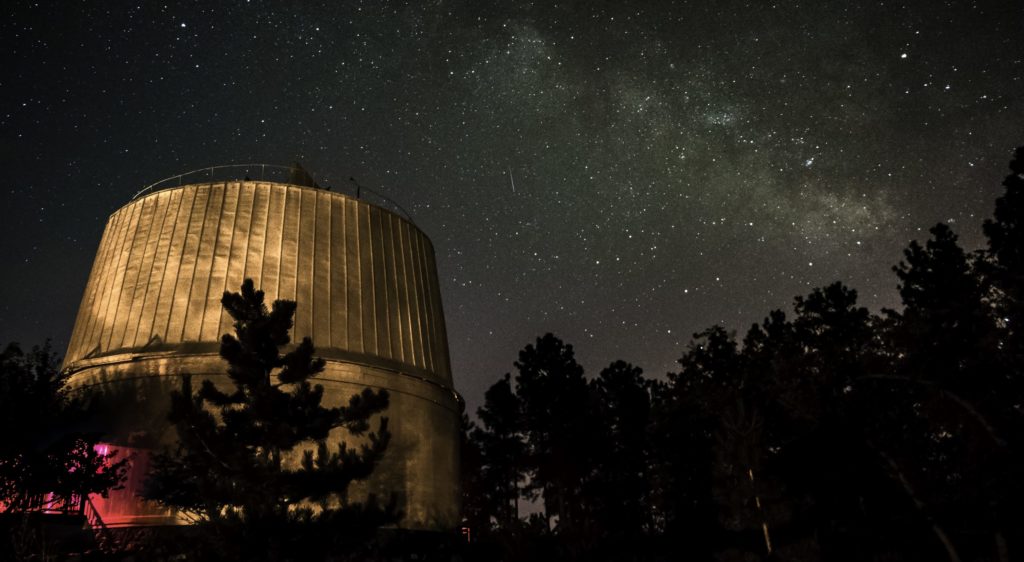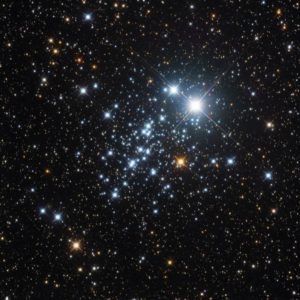
Photo: the Clark Dome | Raymond Dake Photography
By Kevin Schindler
In the opening scene of the 1963 epic comedy film, It’s a Mad, Mad, Mad, Mad World, Jimmy Durante’s character, Smiler Grogan, shares the secret of a fortune buried under a “Big W” before (literally) kicking the bucket. Following a madcap pursuit across California, everyday people turned treasure hunters find that the Big W is a quartet of leaning palm trees growing in a w-shaped pattern. The scene was shot in Rancho Palos Verdes, where the real-life trees have long since died. But, like the mythological hunter Orion, who after his death was elevated to the heavens and survives in the form of a constellation, a Big W of stars punctuates the night sky as part of a constellation that boasts a variety of astronomical treasures. Among these stars, nebulae, and remnants of cataclysmic explosions is the Owl Cluster, a distinct collection of stars popular among sky watchers for its elegance and stark beauty.

The Owl Cluster | Leonardo Orazi
The Owl Cluster is officially recognized in astronomical circles by its catalog number, NGC 457. This means it’s the 457th entry in the New General Catalog, a register of some 7,800 “deep sky” objects—astronomical bodies, other than individual stars, outside of our solar system and including galaxies, nebulae, star clusters, and the like.
NGC 457 is located beneath the Big W of stars that dominates the constellation Cassiopeia, the queen of Ethiopia. British astronomer William Herschel first detected it in 1787, six years after his more famous discovery of the planet Uranus. Located 7,900 light years from our solar system, it is an open star cluster that formed about 21 million years ago, when camels ran wild across the western portion of modern-day Arizona (long after these animals left the area, explorer Edward Beale brought their descendants back during his 1857 construction of a wagon road that passed through Flagstaff).
NGC 457 is an open, or galactic, star cluster, a group of hundreds to thousands of physically related stars located in the spiral arms of galaxies like our Milky Way. The stars are relatively young and sometimes still surrounded by gas and dust left over from their formation. They developed together during a burst of star formation but over time will gradually disperse. Astronomers have identified more than 1,100 such clusters in the Milky Way, though this is likely just a fraction of the total that number that exists.
Open clusters are different than another type of star cluster—globulars—in a number of ways. Opens are much younger (less than 10 billion years old; globulars are more than 11 billion years old), have far fewer stars (hundreds to thousands, rather than tens to hundreds of thousands), and are located in spiral arms emanating from the central bulge of galaxies (globulars tend to live in a spherical halo that spreads beyond the periphery of the central regions).
NGC 457 is not quite visible to the unaided eye, but is quite striking through binoculars or a small telescope. It is highlighted by two bright foreground stars—stars that are not actually part of the cluster, but lie in the line of sight between Earth and the cluster.
The distinct arrangement of this pair, along with the fainter cluster stars, forms a pattern that some people think looks like an owl with its wings outstretched—thus the name Owl Cluster. The pattern has also given rise to other nicknames, including the Kachina Doll Cluster, ET Cluster (as in ET, the movie character), the Dragonfly Cluster, and the Skiing Cluster. No matter what we call it, this collection of stars is a visual and scientific treasure in Cassiopeia and worth exploring.
[vcex_divider color=”#dddddd” width=”100%” height=”1px” margin_top=”20″ margin_bottom=”20″]
Can’t get enough Lowell in your life? Subscribe to our Youtube channel to get even more out-of-this world content!
[vcex_button url=”https://www.youtube.com/channel/UC4zmFY211sXfEamwmsJcrYA” title=”Visit Site” style=”flat” align=”center” color=”red” size=”small” target=”self” rel=”none”]Subscribe Today[/vcex_button]